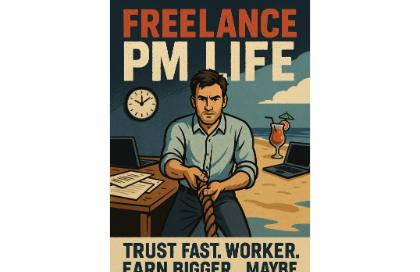This Is What Nobody Tells You About Freelancing and Managing Big Projects
Everything you need to know
Today is a special edition of TheIndiePreneur.
Since many of my readers are Product Managers, I decided to bring in a professional to discuss what’s hidden behind being a PM and doing freelance work.
His name is
, and I’ll let him take it from here.Hello everyone,
Thanks so much to Orel for this opportunity!
Since Orel's newsletter dives deep into solopreneurship, I thought I'd tackle something I've been really curious about lately: Can Project Managers actually make it on their own as freelancers or consultants?
The main concern centers on trust. PMs must build 360º trust with project stakeholders (from C-level executives to development teams). Freelancers might have management's initial trust, but winning over an established team as an outsider can be a challenge.
Building 360 Trust
Trust makes or breaks any PM's success, but freelancers face unique challenges. Joining an existing team requires quickly proving your worth to everyone involved. This means rapidly understanding problems, communicating clearly, taking initiative, and showing you're actively working towards project goals.
However, teams can be cautious with new leaders. Freelancers must proactively build bridges through one-on-ones, collaboration, and ensuring people feel heard. In-house PMs often have an advantage here since they built rapport through past projects. Freelancers are often temporary, and trust is built through actions and feedback. Some examples include demonstrating solid preparation, punctuality (both online and in-person meetings), and informal team-building gatherings.
The Money's Good, But There's a Catch
A major appeal for freelance PMs is higher earning potential compared to in-house roles. While rates vary, the difference can be significant. But this comes with trade-offs, since when the project is close to finish, the freelance contract might be terminated ahead of time. Those higher rates must cover “in-between” project periods.
Often, successful freelancers have multiple projects at the same time. This frequently leads to longer working hours than typical in-house roles (10 or 12+ hour days). If you value a predictable 9-to-5, understand that the freelance reality is often more demanding.
This directly impacts work-life balance, and international projects can require travel. Which comes with the cost of sacrificing personal time, gym sessions, family commitments, and social plans. Finding a sustainable balance between a demanding freelance career and personal life is a major ongoing challenge.
Getting Your Name Out There
The best freelance PMs know how to market themselves and build connections. They proactively identify opportunities to add value and aren't shy about highlighting their skills.
A strong network is perhaps the most critical asset, and word-of-mouth referrals are key. Good work on one project often leads to more opportunities and recommendations. Without actively cultivating a network, freelancers risk getting stuck with limited work or needing to seek permanent roles again, which brings its adjustments (bye-bye, remote working!).
What’s On The “Project” Menu?
Beyond compensation, project variety is a significant benefit. In-house PMs can sometimes get stuck on less exciting projects. Freelance PMs, however, are often hired for strategic, high-priority initiatives requiring specialized skills. So freelancers are often called to the most interesting projects sponsored by the company, which is great for creating a portfolio of experiences and overall enjoyment at work.
How to start?
This part might be tricky since success often comes from hustling early or leveraging extensive experience and contacts:
Networking and referrals remain the most reliable ways to find work.
Referrals and direct networking consistently are way better than freelance platforms (like Upwork or Fiverr)
The initial success will usually depend heavily on people who already trust you,
Figuring Out What to Charge
My recommendation is to research market rates via job postings (like LinkedIn) or by talking with people who are also freelancers. The rates vary depending on geography and experience. Be mindful of taxes and “in-between projects” time, which can heavily trick someone into thinking the rate is good and being surprised with a tax bill or unpaid time.
Legal Stuff You Need to Sort Out
You'll likely need a formal business structure (like an LLC). My strong recommendation is to invite an accountant friend for a coffee and ask direct questions about how to set up an LCC structure.
They understand the requirements for setting legal forms, handling taxes, and navigating regulations like VAT (for Europe) to your benefit. For Europeans, the possibility to get money back from VAT expenses is a great start for tax optimization. Check with your accounting friend for more details since it can vary from country to country.
Final Words
Freelance product management has some great rewards but demands quick trust building, effective networking, and careful work-life balance planning.
Consider starting with a hybrid approach to test the waters before fully committing.
Remember:
successful freelance PMs aren't just technical experts. They're relationship builders, communicators, and business operators.
Whether it becomes your full-time pursuit or a side hustle, the experience will sharpen your skills in valuable ways.






Freelancing sounds exciting and I sometimes think I'd like to do it, but the fear of the unknown keeps me back. I worry that I won't have the steady income that I need to support my family and just pay the bills.